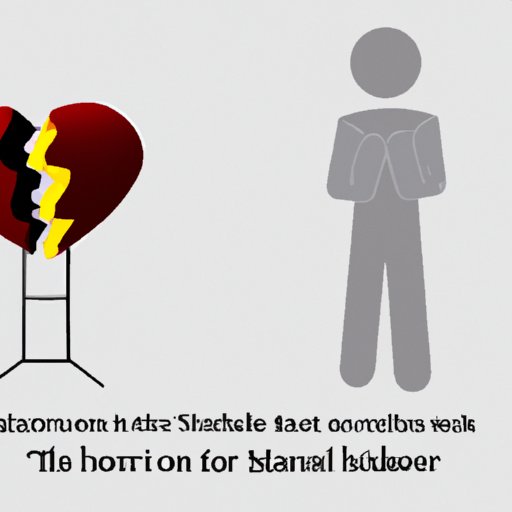Introduction
Heartbreak is a feeling that most people experience at least once in their lifetime. It can be described as an intense feeling of sorrow or distress caused by the loss of a loved one, a break-up, or any other form of rejection. Writing about heartbreak can be challenging, but it can also be a cathartic experience for the writer. In this article, we explore how to effectively describe the emotion of heartbreak in writing.
Use Vivid Imagery to Capture the Emotion of Heartbreak
Vivid imagery can be an effective tool for conveying the emotion of heartbreak. By using concrete details to describe the physical sensations associated with heartbreak, such as an aching chest or an empty stomach, the reader can more easily imagine what it feels like to experience heartbreak. Additionally, imagery can be used to capture the intangible emotions associated with heartbreak, such as loneliness, despair, and sadness. Here are some examples of powerful imagery used to describe heartbreak:
- “My heart felt heavy, like a stone sinking in quicksand.”
- “The tears stung my eyes like drops of acid.”
- “My throat was tight, like I had swallowed a lump of coal.”
When using imagery to capture the emotion of heartbreak, it is important to choose words that accurately depict the feeling you want to convey. Additionally, it is important to be specific and avoid clichés. Here are some tips for using imagery effectively when writing about heartbreak:
- Choose words that evoke strong emotions.
- Be specific and avoid clichés.
- Focus on describing physical sensations.
- Think about how the environment affects the emotion of heartbreak.

Create a Metaphor or Simile to Compare the Feeling of Heartbreak to Something Else
Metaphors and similes can be a powerful tool for describing the feeling of heartbreak. By comparing the feeling of heartbreak to something else, such as a storm or a desert, the writer can create a vivid image in the reader’s mind. Here are some examples of metaphors and similes used to describe heartbreak:
- “Heartbreak was like a hurricane, ripping through me with no mercy.”
- “My heart felt like a desert, barren and desolate.”
- “My sadness was like a fog, obscuring everything around me.”
When creating a metaphor or simile to describe heartbreak, it is important to choose words that accurately depict the feeling you want to convey. Additionally, it is important to be creative and avoid clichés. Here are some tips for creating effective metaphors and similes when writing about heartbreak:
- Choose words that evoke strong emotions.
- Be creative and avoid clichés.
- Focus on describing the intensity of the emotion.
- Think about how the environment affects the emotion of heartbreak.

Describe a Scene from the Point of View of Someone Experiencing Heartbreak
Describing a scene from the point of view of someone experiencing heartbreak can be an effective way to capture the emotion of heartbreak. By focusing on the physical environment, the writer can create a vivid image in the reader’s mind. Here are some examples of scenes described through the lens of heartbreak:
- “The room was dark, shadows dancing along the walls like ghosts. Everything seemed still, but my heart was racing, like a drum beating out a frantic rhythm.”
- “The sun was setting, the sky streaked with orange and pink. I watched it fade away, feeling like my hopes and dreams were slipping away with it.”
- “The wind whipped around me, icy and harsh. I felt so alone, like I was standing in the middle of an empty ocean.”
When writing a scene from the point of view of someone experiencing heartbreak, it is important to focus on the physical environment and the emotional response to it. Additionally, it is important to be specific and avoid clichés. Here are some tips for writing such scenes effectively:
- Focus on the physical environment and the emotional response to it.
- Be specific and avoid clichés.
- Focus on small details that evoke strong emotions.
- Think about how the environment affects the emotion of heartbreak.

Share Personal Stories of Heartbreak
Sharing personal stories of heartbreak can be an effective way to capture the emotion of heartbreak. By sharing a story from your own experience, the reader can more easily relate to the feeling of heartbreak. Here are some examples of personal stories of heartbreak:
- “I remember the day she told me it was over. My heart felt like it had been ripped out of my chest, and I couldn’t move or speak. I just stood there, feeling numb and empty.”
- “I never expected my parents’ divorce to hurt so much. I felt like I was being torn in two, my life suddenly thrown into chaos.”
- “I spent hours lying in bed, my thoughts spinning in circles. I felt so alone, like I was drifting away from everyone and everything.”
When writing a personal story of heartbreak, it is important to focus on the emotions you experienced and the physical sensations associated with them. Additionally, it is important to be honest and avoid clichés. Here are some tips for writing personal stories:
- Focus on the emotions you experienced and the physical sensations associated with them.
- Be honest and avoid clichés.
- Focus on small details that evoke strong emotions.
- Think about how the environment affected the emotion of heartbreak.
Incorporate Symbolism to Evoke the Feeling of Heartbreak
Symbols can be a powerful tool for conveying the emotion of heartbreak. By incorporating symbols that represent the feeling of heartbreak, such as a broken heart or a wilting flower, the reader can more easily understand the emotion of heartbreak. Here are some examples of symbols used to capture heartbreak:
- “The night sky was filled with stars, each one a reminder of my broken heart.”
- “The wind blew through the trees, carrying with it the echoes of my pain.”
- “The waves crashed against the shore, washing away my sorrows.”
When using symbols to capture the emotion of heartbreak, it is important to choose symbols that accurately depict the feeling you want to convey. Additionally, it is important to be creative and avoid clichés. Here are some tips for using symbolism effectively when writing about heartbreak:
- Choose symbols that evoke strong emotions.
- Be creative and avoid clichés.
- Focus on depicting the intensity of the emotion.
- Think about how the environment affects the emotion of heartbreak.

Utilize Literary Devices Such as Personification and Alliteration to Illustrate Feelings of Sadness
Personification and alliteration are literary devices that can be used to illustrate feelings of sadness. By personifying an object or using alliteration to convey a feeling, the writer can create a vivid image in the reader’s mind. Here are some examples of personification and alliteration used to describe heartbreak:
- “My tears trickled down my cheeks like tiny rivers of sorrow.”
- “The silence screamed in my ears, a deafening reminder of my loneliness.”
- “My heart pounded in my chest, a relentless rhythm of despair.”
When using personification and alliteration to capture the emotion of heartbreak, it is important to choose words that accurately depict the feeling you want to convey. Additionally, it is important to be creative and avoid clichés. Here are some tips for using literary devices effectively when writing about heartbreak:
- Choose words that evoke strong emotions.
- Be creative and avoid clichés.
- Focus on describing the intensity of the emotion.
- Think about how the environment affects the emotion of heartbreak.
Compare Heartbreak to Other Forms of Pain and Suffering
Comparing heartbreak to other forms of pain and suffering can be an effective way to capture the emotion of heartbreak. By comparing heartbreak to a physical injury or illness, the reader can better understand the depth of the emotion. Here are some examples of comparisons between heartbreak and other forms of pain and suffering:
- “Heartbreak was like a broken bone, the pain unbearable and unrelenting.”
- “My heartache was like a fever, burning inside me and consuming my every thought.”
- “My grief was like an infection, spreading through my body and taking over my life.”
When making comparisons between heartbreak and other forms of pain and suffering, it is important to choose words that accurately depict the feeling you want to convey. Additionally, it is important to be creative and avoid clichés. Here are some tips for making effective comparisons when writing about heartbreak:
- Choose words that evoke strong emotions.
- Be creative and avoid clichés.
- Focus on describing the intensity of the emotion.
- Think about how the environment affects the emotion of heartbreak.
Conclusion
Writing about heartbreak can be a difficult task. However, with the right tools and techniques, it is possible to effectively capture the emotion of heartbreak in writing. Through the use of vivid imagery, metaphors and similes, personal stories, symbolism, and literary devices, writers can create a vivid image in the reader’s mind and evoke the feeling of heartbreak. Hopefully, this article has provided useful insight into how to effectively describe heartbreak in writing.
(Note: Is this article not meeting your expectations? Do you have knowledge or insights to share? Unlock new opportunities and expand your reach by joining our authors team. Click Registration to join us and share your expertise with our readers.)
